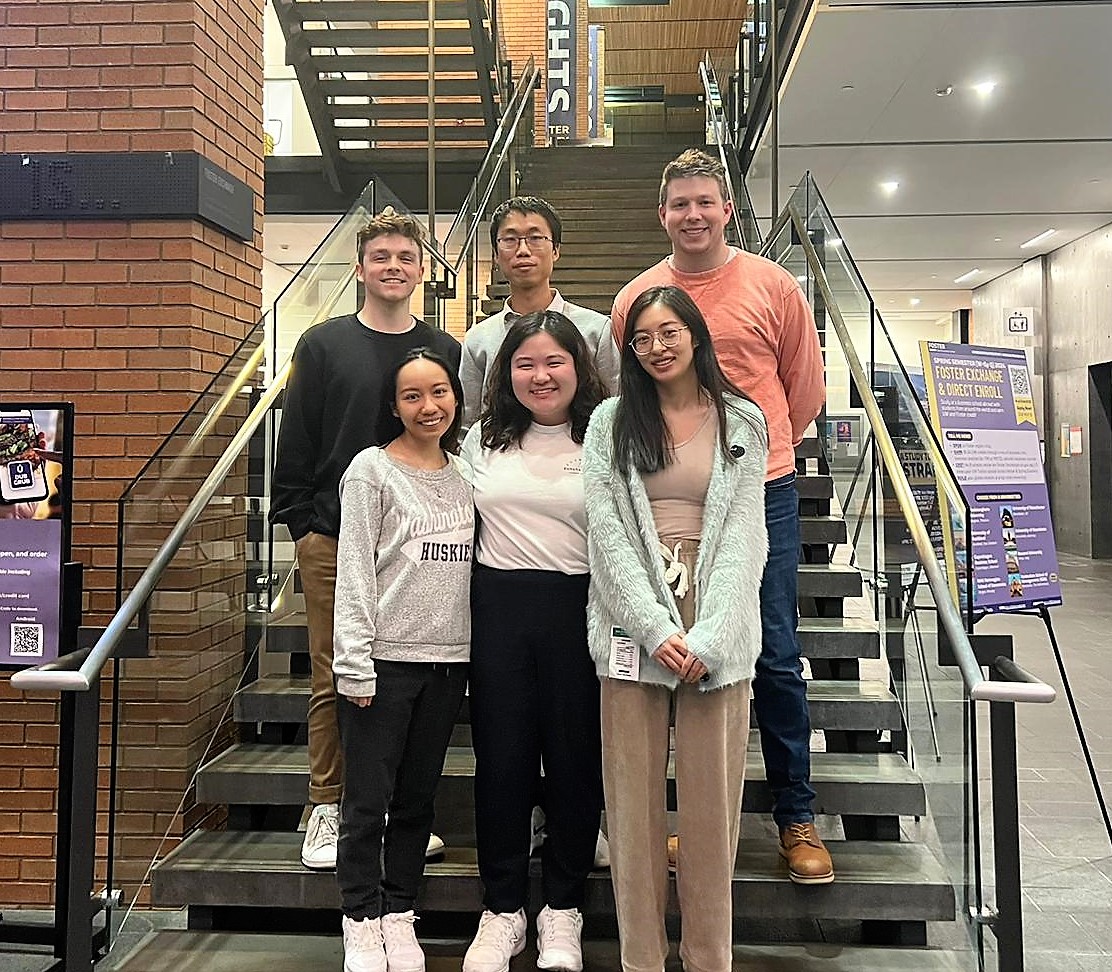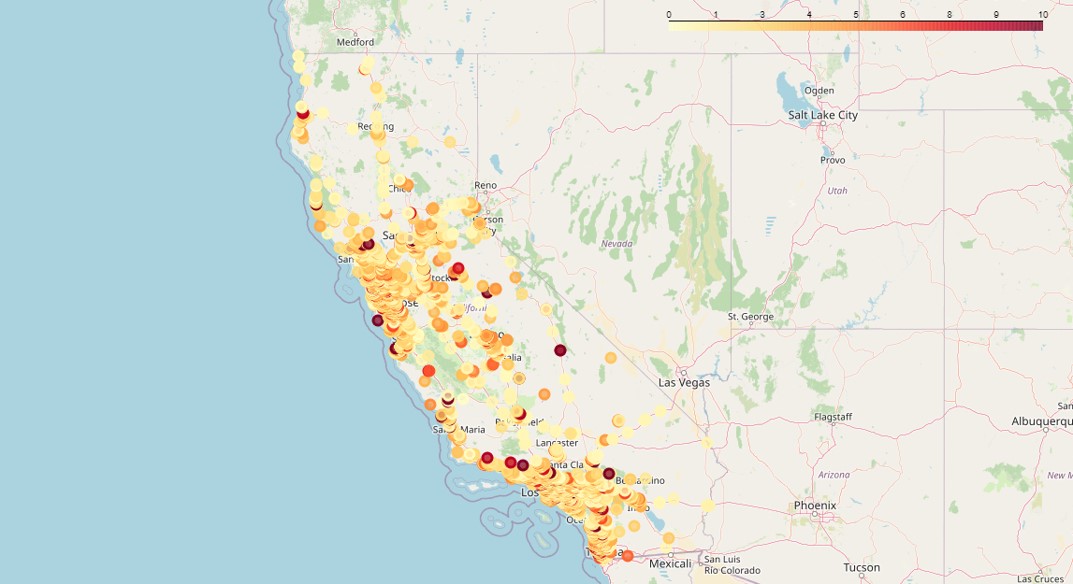Master of Science in Business Analytics Students Work with GM
Foster Master of Science in Business Analytics students work with GM to re-imagine the power grid in the age of EVs
Energy demand changes throughout the day, and utility companies have to generate enough energy in real time to meet that demand—or risk rolling blackouts. As the nation works towards an EV (electric vehicle) future, automakers and utility companies need to determine how to effectively and efficiently manage energy demands.
A group of students in the Master of Science in Business Analytics Program at the University of Washington Foster School of Business is collaborating with General Motors to determine how telemetry data can be used to simulate driving behavior and charging patterns in order to forecast the amount of total energy that may be available to send back to homes, buildings and/or the power grid.
The Foster team is analyzing aggregated and anonymized vehicle data collected by GM to create models determining optimal times of day for vehicle charging and the potential to temporarily return power back from cars to the grid when necessary.

“Human behaviors are highly correlated in time,” explains Russell Walker, an associate teaching professor of marketing at Foster, who is overseeing the students’ capstone project. “We all go home after work and turn on the air conditioner. And people do something similar with their EVs. They come home and charge the vehicle in the evening. As more and more people are using EVs and are charging them at home, it creates a mass spike in demand on the power grid.”
This is a particularly serious problem as states are already struggling to meet demand for electricity, resulting in “brown outs” in times of severe need. Texas suffered a series of deadly outages after a winter storm in 2021, and nearly a million homes lost power during a 2020 heatwave in California.
Complex problem, complex solution
Fortunately, while many EVs may be plugged in, on average, from 5 p.m. to 8 p.m., they all don’t necessarily need to be charged at once. Instead, EVs could potentially serve as a source of power when the need is particularly high during the early evening, then be recharged overnight when demand is lower.
The formula to optimize the input and output schedule of potentially millions of vehicles to maximize the amount of available energy while still ensuring drivers can use their cars when needed is a massively complex analytics task. “It requires knowing where all the vehicles are, if they are being used, what their charging levels are, and even if they’re likely to soon be used,” Walker says.
That’s where the Foster team comes in. GM and the University of Washington combined efforts to create a class, granting six Foster students access to the valuable vehicle telemetry data points and an open-ended question of how to make the most of it.
“As GM shifts to an all-electric, more sustainable future, data insights and understanding human behavior around charging habits will be key to preserving energy across the country,” says Aaron Shaffer, director of analytics innovation at GM. “By collaborating with the University of Washington’s Foster School of Business and its students, we’ve created a learning opportunity for students who will soon be in the data science field, while giving GM an outside perspective to better sustain the power grid as EV adoption grows.”
The California case
The Foster team took on the challenge of determining everything, from what tool set to use to how to divide the work among the team.
“Communication was key,” says team member Chen Zhou (MS 2023). “This project provided us with a remarkable degree of flexibility, empowering us to fine-tune the initial scope according to our specific requirements. We were fortunate to receive valuable data, which brought forth an invigorating challenge of uncovering its complete potential and leveraging it to generate significant benefits.”
As GM is focused on protecting the privacy of its customers and security of data, all modeling work had to be done within the GM firewall via remote cloud access. As the team dove in, they quickly realized the need to arrive at a subset of data small enough to be actionable but broad enough to be scalable and applicable to GM’s entire customer base.

“We chose California, because the data from there was large and relatively clean,” says Patrick Hooley (MS 2023). “And California has a great blend of urban and rural areas. We’ve been using geo-hashing to analyze different parts of the state to assess their demands independently. For this to be useful, we needed to make sure that there was enough granularity to the grid element, because there are so many different electrical grids that service specific pockets of the country.”
Essential segmentation
The project entailed research to understand California’s energy supply and demand, and predictive analytics via machine learning to project future needs.
With the geographic region defined, the next step was utilizing Databricks, a database analysis software, to create models around real-world customer behavior.
“We took the approach of looking at all of the different vehicles in our data set and clustering them into groups based on specific characteristics,” says Lyndsey Shimazu (MS 2023).
Benefits all
The opportunity for consumers to benefit from such a program is one of the most promising aspects of the rare arrangement in which everybody wins. Consumers can monetize their vehicle’s batteries when not in use. Utilities don’t have to charge a massive number of vehicles at once and can tap into an additional power supply. And all benefit from avoiding the astronomical cost of added power plants and the accompanying environmental impact.
GM is heavily invested in all aspects of EVs, including developing its own proprietary technology and producing electric versions of everything from luxury cars, like the Cadillac CELESTIQ, to pickup trucks, like the Chevrolet Silverado EV.
“GM is undertaking a massive transformation as we shift to an all-electric future,” said Jon Francis, GM’s chief data and analytics officer. “Data and insights not only play a critical role in advancing our vision of ‘Zero Crashes, Zero Emissions and Zero Congestion,’ but they will be key to getting everyone in an EV.”
GM recently announced plans to integrate the North American Charging Standard (NACS) connector deign into its EVs beginning in 2025.
Purpose-driven problem solving
Zhou, Hooley, Shimazu and fellow team members Davis Coats (MS 2023), Vicky Zhang (MS 2023) and Mai-Lan Hoang (MS 2023) recently presented their findings to an audience of over 100 GM employees. Boiling down hundreds of hours of work into a 30-minute presentation presented another challenge, but the Foster team’s work was very well received.
“The countless hours Foster students dedicated to this project and the end findings presented is inspiring,” says Shaffer. “GM gave a crucial task to these students, and we were impressed with their analytical and creative approach to a real-world problem.”
The students also appreciated the support and learnings from the many hours spent discussing the problem and data with the GM team.
Just as the overall concept is mutually beneficial to GM, consumers and utility companies, the project itself was valuable to both GM and the Foster participants. And the Foster students gained experience with new tool sets and can apply their learnings to data challenges at companies where team members work today, including Alaska Airlines and PwC.
“I think it is a great project and very much aligns with Foster’s values,” says Walker. “The students have an opportunity to work with a company on a real-world project that stretches them and allows them to apply the things they learned in the MSBA Program. And this project is especially interesting because EVs are critical to our students’ generation. Everything I have heard from the students and GM has been very positive. And I’m not surprised. Because we have great students, and this is a project that aligns with their interests.”
